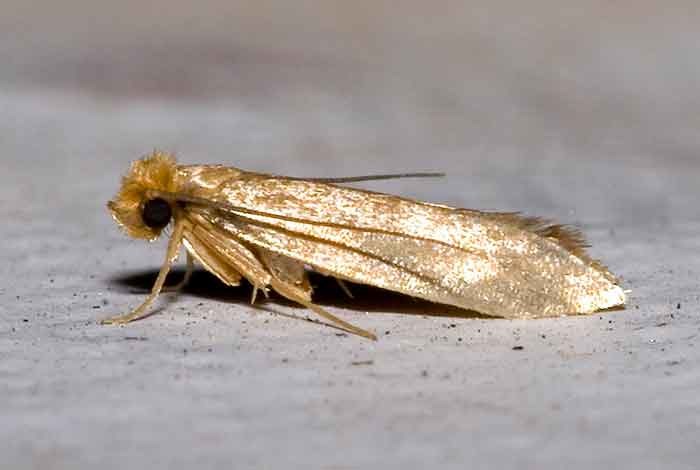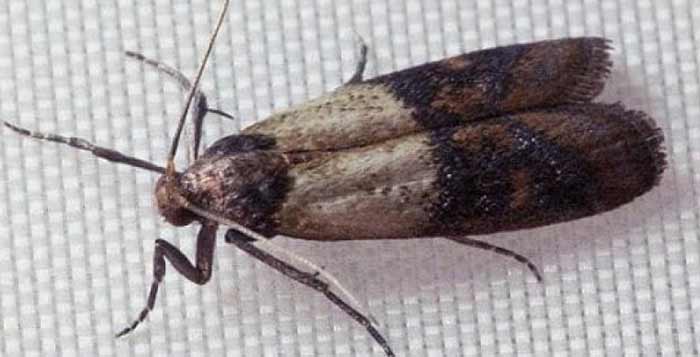Some species of moth have a particular liking to stay indoors. If you’ve seen them or you suspect you may have an infestation, you are in the right place. Find out how you can you identify house moths what are they attracted to, their habitat and much more.
Table of Contents
Where Do Moths Come From?
Just as insects, roaches, bugs and other species enter our homes through cracks on the windows and spacing on the door frames, so does the moth. The female and male moths will fly towards the inside of the home in search of a habitat, after which once they find a pleasant place, they will begin their reproduction process.
With the pantry moth, they can enter the home from openings in the windows or doors, or alternately, from good bought at the store. If you don’t keenly check your groceries you may carry an infected meal/ food back home which will then infect every other item in the pantry within days.
As for the clothes moth, they particularly don’t like light, which is quer behavior compared to other moths, but that’s how they infest the clothing. They will hide undergarments in second-hand shops which you will buy and carry back home with you. This is why you need to adequately clean any bought attire before wear.
Use any preventative measures to stop an infestation on moths once the moths have already gained entry. Besides, you may not be able to control everything that enters your home.
House Moths Identification
As mentioned previously, there are different house moths species. These are;
- Tinea Bisselliella- also known as the common clothes moth.
- Tinea Pellionella- the case bearing clothes moth.
- Indian meal moth – this the pantry or kitchen moth.
- Brown house moth
These are the common species likely to be found in your home. In order to know if they have infested your home, you have to know how to identify them. Here’s a look at each of them describing their distinct features one after the other.
1. Tineola Bisselliella
Commonly referred to as the common clothes moth, the Tineola bisselliella is one of the most known moth species. It thrives mostly in natural fibers, precisely wool or fur, where it also lays its eggs and where the larvae develop. More so, these moths can also be found in food, especially grains stored away in cabinets.

The moth is rather small compared to other species, meaning only seven millimeters in length and a wingspan of nine to 16 millimeters. They have a distinct yellow-brown/ mustard/ ocherous hue on their body and a red-orange hair tuft on their head.
Their larvae or caterpillar stage has the insect looking white in color with a dark or brown head. They can easily be spotted on fur, even though they are microscopic in size. Once they turn to the adult stage, you only see the cocoons as the imago doesn’t have mouthparts to chew on the fabric. So if you see these cocoons in your closet, you have an infestation.
2. Tinea Pellionella
Similar to the tinea bisselliella, this is the case bearing clothes moth. A fungus moth that’s also very tiny in size just as the one above. It is found widespread throughout the world with appearances mostly in summer and autumn.
It’s grey in color with a tint of light brown. The hairs on its head are darker in hue, however. The wingspan varies from 9 to 16 millimeters. Both forewings and hindwings have tiny hairs and indistinct dark spots. They can feature different coloring where the forewing is brown and hind is grey.
To check for them in your home, look for the larvae on clothing, carpets, floor, skirting boards and upholstery. They can also be found in the kitchen pantry feeding on dried fruits and nuts
3. Indian Meal Moth
Another frustrating house moth is the Indian meal moth also referred to as the pantry moth. As the name suggests, it dwells and thrives on cabinet grains and food where its larvae too develop to the adult moth. They are known to attack just about any food in the house from grains, dried fruits like dates, pet foods, seeds, nuts and even fried milk.

As they feed on the grain, they leave behind a silken thread, which then poses a threat to the food as it webs the food particles together. This means the food is no longer consumable or rather toxic for consumption. To identify such a moth, they tend to fly in a zigzag manner, they are pale grey in color, with a copper luster on their forewing.
The pantry moth is best known to form webs in food particles combining them together which also causes them to become stale and toxic for consumption. They can be found anywhere and can be transferred from one place to another. Hence be careful where you buy your food and also check the product before you buy it.
Another pantry moth close to this is the Mediterranean flour moth that thrives in flour. Baking floor, rice floor, self-raising, just to mention a few. The larvae will live on the floor for as long as it needs to develop to an adult. It is important to note that they can also be introduced to your pantry through flowers and wreaths.
4. Brown House Moth
This is a species from the concealer moth family. It thrives in food just like the Indian meal moth/ pantry moth. Its origins date back to Asia from where it has widely spread throughout the world. Similar to other moths, it also has a four-stage metamorphosis where the larva/ caterpillar is what causes the most damage in the house.
The larva which isn’t longer than an inch is whitish in color with a brown body and head. It feeds on organic debris and detritus indoors as well as outdoors. From inside the house, they hide behind skirting boards, carpets and in crevices of the home. They are known to attack cereals, maize, oats, barley, wheat, rice, seeds, pet food, and potatoes.
House Moth Damage
Unfortunately, the house moth is not a pleasant pest, it can cause horrific damage to your home, clothes, and kitchen – especially the pantry. And because you may be unable to identify a moth just by looking, attributed by their microscopic size, the next best thing is to look into your damaged areas.
- Damaged fabric – the moths may not chew in the fabric like rats, but they can create holes on the fabric. Irregular holes and shapes that make the cloth look unpleasant.
- In some cases, you might see regularly shaped holes – these will be from the case bearing clothes moth.
- Chewed parts of leather – the brown house moth tends to prefer heavier and animal-based fabrics like leather.
- Cocoons inside food storage cabinets. There could also be dirt in the pantry from the larva evolving to the pupa stage.
These are only but a few signs of damage that can be seen in your home.
What Attracts or Causes Moths?
Before one looks for ways to get rid of moths, the first step is always to look at what attracts them. Below are some of the causes of moth infestations;
- Presence and absence of light – for most moths, they are very attracted to light. The adult moth will fly over the light as many times as they want sometimes in search of a partner. For the larvae, however, they prefer darkness. That’s is why they will hide inside the clothes and in the dark corners of the pantry.
- Adequate food – the Indian meal moth is attracted to bulk varieties of foods. Whether its flour, cereals, seeds or fruits, as long as you have them, they will be there.
- Warm clothing – not for the warmth but the clothes moth love wool and fur because they seem to have an extra element in the clothing that’s best to serve as a habitat.
- Unattended food – regular moving and using of food disturbs the moth’s peace hence they will not breed in floor, food or clothing that’s constantly moved, shaken or washed.
Plenty of food, dark environments, and easy entry sums up what causes moth infestation. If you have any of this in your home, you should invest in ways of getting rid of or preventing them from further infestations.
Lots of Small Moths Flying Around the House, What it Means
There are people who believe in superstitions led by their spiritual beliefs, while others just look at things from a scientific view. For this section, we shall look at both.
Scientific
If you see many moths flying around your house, it simply means there is a presence of rotten food somewhere in the house or in your trash. Sometimes you could have forgotten to empty the bin meaning there will be a foul smell and other attractors for the moth.
Spiritually
Many people associate the presence of numerous moths with negative superstitions. Similar to how many believe an owl is a dark sign of death, others to associate that same belief with moths. They are an unpleasant sight that many assume bring misfortune to one’s life. These spiritual beliefs, however, are not backed up by any evidence of being true or false, they’re simply beliefs.
Where do Moths live in the House?
There are two common species that habitat in the house, they are:
- Tinea Bisselliella
- Indian meal moth
The common clothes moth and the pantry moth are respectively found on your clothes and in the kitchen, specifically; the pantry. They have a liking to indoors as they are the perfect hosts. These house moths will live, grow and develop from either of these habitats until they are adults after which they’ll fly away in search of mating partners.
The Indian meal moth also referred to as the pantry moth will be found in most of your foodstuffs like cereals, grains, nuts, seeds, or store-bought foods. Once the female moth lays the eggs, they’ll hatch into larva which then webs around the food.
To check on whether you are infested by these, check your food for webbed food particles brought together by the glue on the larvae that stick in food as it moves. You should also see whitish worms/ caterpillars about 0.6 inches long with a blackhead.
For either the common or case bearing house moth, you should check on your clothes, specifically those with wool or fur fibers. They hold the highest number of spacing between the fibers hence good breeding places for the larvae. They will habitat anywhere on the clothing from armpits, the insides or just in the top. You should see a whitish larva hanging on the clothes they can easily be scraped off by brushing.
Besides the closet or pantry, the moths can also look for other habitats in the home like on walls next to crevices, the floors, skirting boards, carpets, or just moldings. You can look for cocoons which tell you they have been there and have developed into the pupa stage. The presence of flying moths also shows they have matured into adulthood, probably leaving their young ones somewhere breeding.
No More House Moths
It is already established that having moths in the house is nothing short of disturbing. From damaged clothes, spoilt food, cocoons lying everywhere in the home, they should habitat in your home. The most essential piece of this article has been knowing how to identify the moths and where to look for them to check if you have an infestation.
The next step after that would be getting rid of them and eventually preventing further infestations.
Further Reading